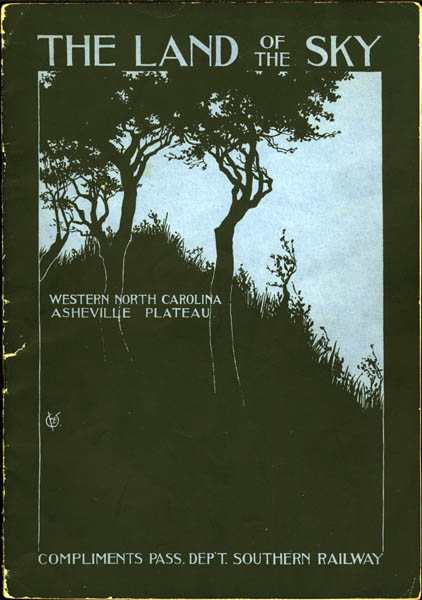|
Page |
Image No. |
Description |
Thumbnail |
| Cover |
lots001 |
"The Land of the Sky":
Western North Carolina, Asheville Plateau.
Compliments Pass Dep't Southern Railway.
|
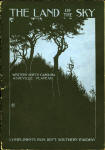 |
| 1 |
lots002 |
"The Land of the Sky": Asheville
Plateau by Frank Presbrey.
Americans celebrate the fourth day of July as one of their great
national holidays. Few there are who recall that it was upon this
identical date, 1584, that the expedition send out by Sir Walter
Raleigh under authority of Queen Elizabeth first landed upon
American soil. Thus the beginning and the ending of English Dominion
in this country occurred on the same day and month.
This expedition landed on the coast of North Carolina and took
possession ''in the right of the Queen's most excellent majesty, as
rightful queen and princess of the same, to be delivered over to the
use of Sir Walter Raleigh according to her majesty's grant and
letters patent, under her highnesses great seal."
Thus North Carolina, or, as it is familiarly known among its
sisters in the Southland, the "Old North State," is not only the
oldest so far as white occupation is concerned, but is entitled to
occupy, by right of her prowess in enterprise, thrift, and natural
wealth, a most prominent place among the greatest States in the
Union.
Upon her soil not only was the first American colony founded, but
under her skies the first white child born in America saw the light
of day. From the very beginning North Carolina stood for freedom and
the rights of the people. She was first of all the colonies to elect
a legislature by popular vote in opposition to a royal governor and
administration, and the first to make a declaration of independence
against the British crown, that of the Mecklenberg on the 20th of
May, 1775. Her representatives were the first of all sent to
Philadelphia, and they bore instructions to propose or concur in the
movement to cast off the yoke of England. Her people were the first
to demand in the framing of the Constitution the admission of the
doctrine that '' all powers not granted are reserved to the people,"
and to declare for an equal representation in Congress of two
Senators from each State. Upon her soil at Alamanca, May 12, 1771,
the first pitched battle against British tyranny was fought. She
was, too, the first colony to secure and establish entire religious
freedom, and the last to pass the ordinance of secession.
Geographically North Carolina is an empire in itself. Its total
length is 500 miles, and it has an area of 52,250 square miles, of
which 59 per cent, is forest. It would hold ten States the size of
Connecticut and six as large as Massachusetts. It has a greater
diversity of climate than any State except California, and could
approximate more closely the maintenance of its inhabitants,
independent of outside markets or products, than any territory of
equal size in the world.
|
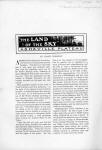 |
| 2 |
lots003 |
"THE VALLEY OF THE FRENCH BROAD IS ONE CONTINUED
PANORAMA OF ROMANTIC AND BEAUTIFUL VISTAS." |
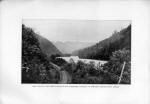 |
| 3 |
lots004 |
The middle portion, known as the Piedmont plateau, is a
wide-stretching-, undulating region of fertile farm lands
unsurpassed anywhere for agrarian purposes, while the eastern or
coastal plain is rich in waterways and in a soil productive to the
highest degree.
There are in North Carolina three great physiographic divisions
or terraces: the Coastal, Piedmont, and Mountain. The White
Mountains are dwarfed in comparison with the sublime heights in the
western or mountain region of the State, where forty-three distinct
peaks attain a higher altitude than Mount Washington, and over
eighty approximate it in height, the mean altitude being greater
than any section east of Colorado.
Reference to the mean parallels of latitude will show that North
Carolina is situated nearly midway of the Union; and inasmuch as the
Union lies entirely within the temperate zone, it follows that North
Carolina is situated upon the central belt of that zone. This
position gives to the State climatical conditions and productive
capacities not excelled by any in the world. As a poetical writer
has put it, ''the Old North State is the marriage altar of Summer
and Winter." On the west the lofty mountain chains interpose their
mighty-barrier between the bleak winds of the northwest and the
general surface of the State. On the east the coast is swept by the
Gulf Stream, the me1iorating effect of which is felt far inland.
From this position and these causes the temperature, |
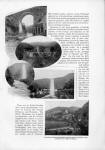
"The scenery along the Southern
Railway between Salisbury and Asheville is of wonderful beauty." |
| 4 |
lots005 |
which is more or less the
life of all vegetation, ranges within moderate limits from season to
season. Including all the sections heretofore named, the range of
climate in North Carolina is the same as that from the Gulf of
Mexico to the Gulf of St. Lawrence. With an average mean temperature
of 59°, there is perfect freedom from torrid heat or the terrors of
winter's grasp. Her skies rival in their azurine tints those of
Italy, and there is a vitality and tonic in the atmosphere which
makes an instant impression on the visitor.
Europe may have her Switzerland, the West its The Mountain Roads
in Colorado, the Pacific coast may glory in her Sierra Nevada, and
British Columbia in her Cascade range, but nowhere on the face of
the earth is there a region more picturesquely, more charmingly
beautiful than the mountain country of western North Carolina,
poetically known as "The Land of the Sky." It is true there are
mountains of greater elevation in each of the localities named, but
the greatest canvases in the gallery of art are not the choicest
gems, or is the beauty of nature to be measured in geodetic lines.
Where the mountain ranges of the West are rugged, barren, and
forbidding, those in western North Carolina are robed in deep-hued
forests to their highest summits. Where the greater peaks of the
Sierra Nevada frown, those of 'The Land of the Sky" smile through
banks of rhododendrons and azaleas. Where the valleys of the one are
rocky and Impassable gorges, in the other they are fern-carpeted
forest labyrinths, through which crystal streams tumble merrily
along over moss-grown rocks in their race to the open. Picture in
your mind a region where range after range of heavily forested
mountains parallel each other like waves of the sea, where
interlacing valleys are rich with verdure and flowers, and where
silver streams murmur unceasingly.
|
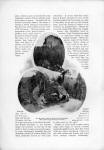
"The Mountain Roads in Western North Carolina
offer splendid opportunity for driving." |
| 5 |
lots006 |
Imagine an air so
light and pure that breathing itself seems a new-found joy, then
throw over all a canopy of bluest of Italian blue, and you have "The
Land of the Sky."
''Land of forest-clad
mountains, of fairy-like streams,
Of low, pleasant
valleys where the bright sunlight gleams
Athwart fleecy clouds
gliding over the hills,
'Midst the fragrance
of pines and the murmur of rills.
"A land of bright
sunsets, whose glories extend
From horizon to
zenith, there richly to blend
The hues of the
rainbow with clouds passing by-
Right well art thou
christened 'The Land of the Sky'
"A land of pure
water, as pure as the air;
A home for the
feeble, a home for the fair;
Where the wild roses
bloom, while their fragrance combines
With health-giving
odors from balsamic pines.
"As far from the
frigid North as from the zone
Where the sun's
torrid rays come sweltering down,
Upraised toward the
heavens whose azure seems nigh—
Right fitly thou art
christened 'The Land of the Sky.'
The mountains that
shield from the rude northern blast—
Mute monitors, they,
of the ages long past—
Like sentinels watch
o'er the valley below;
Where the swift
crystal streams unceasingly flow.
"The pure, healthful
breezes, the life-giving air,
The beauteous
landscapes, oft new, ever fair,
Are gifts that have
come from the Father on high;
To Him be all praise
for ' The Land of the Sky.' "
|
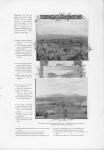
The City of Asheville is in the
centre of a magnificent natural plateau entirely surrounded by
mountains. |
| 6 |
lots007 |
"THERE ARE MANY PICTURESQUE IF NOT ANCIENT RELICS
OF BY-GONE DAYS." |
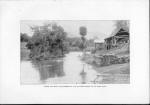 |
| 7 |
lots008 |
Springs, the traveler does not pass over a mile
of uninteresting territory. As the train begins its tortuous ascent
of the mountains, which seem to be piled up in impassable
massiveness, the scenery becomes grand, then inspiring, and finally,
as the summit is approached, sublime. The two monster "creatures of
iron and brass" attached to the train make the mountain fastnesses
re-echo with their stentorian puffing as they drag their heavy load.
The track is now clinging to the very edge of the mountainside, and,
a moment later, crossing a dark rock-cleft ravine on bridge of
steel, beneath which a stream lashed into foam is fighting its way
to the valley. Another turn in the twisting path of iron and such a
magnificent valley opens out before you that you involuntarily utter
an exclamation of rapture. The most glorious works of nature are
being shifted upon the easel of your vision with kaleidoscopic
rapidity. Up and up you climb, the horizon broadening as you
approach the summit. Forest-crowned peaks loom up in the background
and dwarf the nearer ones. You catch glimpses of the track in
fourteen different places where you have passed. The world seems at
your feet. One brief and entrancing view is had just as the train
plunges into the Swannanoa tunnel which pierces the topmost strata
of the mountains. You enter it from the Atlantic slope and emerge on
that of the Mississippi and the Gulf. It is the dividing line, and
the Crystal Spring, in its centre, as if in demonstration, sends out
two streams, one flowing to the east and finding its way to the
Atlantic Ocean, |
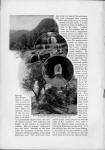
"The crest of the mountains is
pierced by a tunnel in which there is a spring, whose waters flow
both east and west." |
| 8 |
lots009 |
and the other to the
west, ultimately reaching the Gulf of Mexico. Just beyond the
tunnel, on the western slope of the mountain range, is Black
Mountain station, 2,466 feet above the level of the sea. Near this
point the lands of the Mountain Retreat Association begin, and they
extend for six miles north to Greybeard, reaching at that point an
elevation of 5,700 feet. This association is composed of Christian
business men and ministers of all denominations. It is their
intention to duplicate, in some respects, in these mountain
fastnesses the work of the Methodists at Ocean Grove. The North
Carolina legislature has granted a charter with ample powers and
generous privileges. The enterprise is a community in the sense that
all profits from the sale of lots will be used for the benefit of
the entire community and for the purposes for which taxes are
usually laid. By the charter the sale of intoxicating liquor is
forever prohibited. Plans are being made for a large and important
educational institution, one hundred acres of land having been set
aside for this purpose, and the resort will also be a centre for
annual gatherings of prominent and earnest Christians at work for
the study of problems relating to the welfare of humanity, and ways
and means for advancing the interests of Christianity through the
various denominations.
|
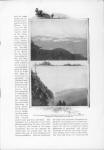
"There are many spots in 'The Land of the Sky'
where the most magnificent mountain views are spread before the
eye." |
| 9 |
lots010 |
The descent from
Black Mountain to the level of the Asheville plateau is gradual and
the passing scenery beautiful. Just where the railroad meets the
lovely Swannanoa River is the handsome station of Biltmore, at the
very corner of the vast estate of Mr. George Vanderbilt.
Two miles beyond is
Asheville, which is the tourist as well as the commercial centre of
this region. It has been called the " Janus of resorts," for, like
that two-faced divinity of the ancient Romans, it has two fronts.
Upon one it wears a welcome for the winter guests from the North,
and upon the other a smiling greeting to the thousands who come here
each summer from the Southern cities to enjoy the cool bracing air
of the mountains.
Asheville has a
greater elevation than any city east of Denver, being 2,300 feet
above sea level. It occupies an ideal site just at the merging of
the ever-beautiful Swannanoa (nymph of beauty) River with the
historic French Broad.
The mountains have drawn away, leaving as fair a valley or
plateau as human eye ever gazed upon. But raise your eyes in any
direction above the immediate surroundings of undulating hills which
have been left by the erosion of the rivers, and they will rest upon
the circling ranges of towering mountains, which give a glorious
setting to the picture. The city of Asheville has had a vigorous
growth. It has an active air of commercial life, and upon every turn
there are indisputable evidences of thrift and prosperity.
Considered from a business and manufacturing point of view, the
place occupies an enviable position among North Carolina's cities,
and as a tourist centre its fame is worldwide. The visitor will find
its streets well paved, and electric cars run through the principal
thoroughfares and into the attractive suburbs. The city has an opera
house, a fine social club, a country club, a golf club, an art
gallery, and a public library. The churches and municipal buildings
are modern and well built. Asheville has become quite an educational
centre, and it has several very well-known institutions of learning
in addition to excellent public schools. The Bingham School for
boys, established in 1793, has long been known as one of the best of
its class in America. The Home Industrial School, maintained under
the auspices of the Board of Home Missions of the Presbyterian
Church, is doing a noble work (continue to page 11) |
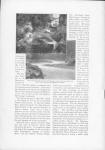
"The North Carolina mountain streams are
exquisitely beautiful with their rocky beds and overhanging
verdure." |
| 10 |
lots011 |
"ALL OF THE WILD MOUNTAIN STREAMS PICK THEIR WAY
THROUGH MASSES OF BOULDERS." |
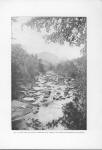 |
| 11 |
lots012 |
in the line of practical
education for girls. The Asheville Normal and Collegiate Institute,
established for the higher education of young women, and under the
control of the Northern Presbyterian Church, is located in a
beautiful park of thirty-five acres, which it shares with the Home
Industrial School. Asheville College, founded in 1842, is designed
to be a school of the first rank for girls and young women. It has a
strong faculty and is doing most excellent work. In addition to the
above, there is a business college in most flourishing condition,
the Misses Champion's school for girls, Skyland Institute, the
Asheville Free Kindergarten Association, with four schools
maintained by private subscription, amid the Asheville Farm School,
occupying 420 acres, which has over one hundred students, who are
taught agricultural work on approved and practical scientific lines.
Asheville has a permanent population of about 14,000, and there are
always a large
number of visitors,
estimated to average several thousand.
The business portion
of the city centers about the public square, where stands the
picturesque old court-house, the modern municipal building, the city
hall, in the basement of which is the public
market, the Legal
Building, the newspaper offices, many stores, and other business
edifices. Here the electric street cars on all the lines converge.
On Saturday afternoon crowds of country people congregate in the
square, and the mountain wagons, cloth-covered and drawn by mules or
steers, lend interest to the scene. Radiating from the square, all
the streets are solidly built up with brick business blocks. On all
sides of these lies the residence part of the town, built on the
undulating land, not too closely—the average residence lot having a
75-foot frontage.
There are few cities
in the South which have a larger number of beautiful residences.
Many people who have been attracted to Asheville because of its
delightful and healthful climate are making it their permanent home,
and have built modern, and in a number of instances, luxurious
homes, one of them, that of Mr. George Vanderbilt, being the most
costly private residence in America. The city is amply supplied with
excellent modern hotels, and there are scores of boarding-houses
where comfortable accommodations may be had. The two leading hotels, |
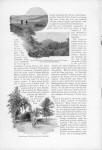
"Mount Mitchell is the highest peak in the United
States east of the Rocky Mountains."
"Along the good bicycle roads about Asheville." |
| 12 |
lots013 |
the Battery Park and
Kenilworth Inn, rank high among the best resort hostelries of the
country, and each has accommodations for from four to five hundred
guests.
It is the peculiar
climatic features of the Asheville plateau, added to its charming
natural scenery, which have given this country its great reputation.
These have been admirably summed up by S. Westray Battle, M.D., in
an article recently published in the Medical Record of New York. He
says:
"Nestled in the heart
of the Alleghanies, cradled bythe Blue Ridge and Great Smokies,
stretches the Asheville plateau, a most desirable and beautiful
section of country, in close touch with the East and North, and most
accessible from all points South and West. It has become the great
sanatorium of the eastern United States. It enjoys a climate
representing the golden mean of altitude and latitude, and the
several meteorological conditions which go to make up a wholesome
and fascinating resort. Nowhere east of the Rocky Mountains is there
anything approaching it to be found for fall and winter, spring and
summer—an all-the-year-round retreat. It is cool in summer, yet the
winters, shorn of their harshness by reason of its southern
latitude, induce almost daily out-of-door exercise in the way of
shooting, riding, driving, or short mountain excursions on foot. For
lovers of golf it is ideal; and at Asheville, the centre of the
plateau, are united the comforts of a city with the delights of the
country.
"The plateau is an
elevated tableland, somewhat triangular in shape, embracing some six
thousand square miles of western North Carolina, with a general
elevation of two thousand feet above the sea level, though altitudes
up to six thousand feet may be had for the climbing any day in the
year. Hills, valleys, rivers, and forests so diversify this
ultramontane expanse as to make it lovely and restful to the eye
beyond the power of my pen to portray.
''The mean
temperature of spring is 53.49° F.; that of summer, 70.72° F.;
autumn, 53.48° F.; and winter, 38.87° F.; while for the year it is
54.14° F., with a mean relative humidity of but 65 per cent.
"There can hardly be
room for controversy that upon this plateau may be enjoyed the
golden mean of American climate. With medium altitude, dry, tonic,
invigorating and ozoniferous atmosphere, the region cannot fail to
grow in popularity as meeting the indications in |
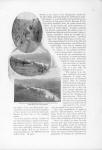
Some of the most charming scenery in America is between Asheville
and the Hot Springs.
|
| 13 |
lots014 |
the cases of a large
majority of health seekers, more especially those looking for the
all-the-y ear-round residence; and it has occurred to the writer
that it should particularly appeal to the retired of the army and
the navy, and to him of modest independence who wants to enjoy his
otium cum dig. away from the busy whirl of the city and
carking care.
In regard to the merits of the climate, or the climatotherapy of
the plateau, let me briefly sum up its advantages without bestowing
indiscreet or over-zealous praise. It is pre-eminently a suitable
one for the early stages of pulmonary phthisis, especially for such
subjects as can and will get out in the air, and are determined to
take the benefit of the dry, tonic, invigorating, bracing qualities
thereof, and keep good hours. Conditions which seem to favor germ
propagation and prolong the species of the genus bacterium do not
exist here. Wounds heal kindly, and operative procedures of the
gravest character are very rarely followed by septic infection. The
mortality from pulmonary phthisis is not large in any part of North
Carolina, being, according to the mortality tables of the tenth
census (1880), 13.4 for every 10,000 of population throughout the
State. But it is interesting to note that the mountain counties show
a mortality of only 10.6 in every 10,000 of population, as against
16.1 for every 10,000 of population of all the other counties of the
State in the aggregate; or, in other words, in a State in which
pulmonary phthisis does not figure prominently in the mortality
tables, the burs of the same death-rate is still fifty per cent,
less in the mountain section than in the other low-lying portions of
the State.
"Among other conditions indicating the advisability of a sojourn
in this region may be mentioned asthma, hay fever, convalescence
from malarial and other fevers (there are no lakes or swamps, and
malaria is unknown), nervous prostration and exhaustion from
over-work or long-continued summer heat, as also chronic congestion
of the internal organs, by reason of diminished atmospheric density
causing a determination of blood to the surface—hence arises one of
the benefits of altitude in incipient phthisis. Nervous energy and
muscular vigor are usually increased, and the nutrition of the body
and the general condition of the blood improved, by a sojourn at
moderate elevation ; above six thousand feet the appetite for food
is diminished and the digestive organs are frequently disordered,
whereas a medium altitude usually increases the desire for food and
quickens digestion. By reason of its medium altitude,
contraindications to a residence upon the plateau are few, though
organic disease of the heart where the circulation is much disturbed
must not be lost sight of. Of course, those who are in advanced
phthisis and are too feeble to breathe the out-of-door air and take
some sort of out-of-door exercise are better off at home with their
friends, surrounded by comforts that cannot be supplied elsewhere."
The drives round about Asheville are unexcelled anywhere for the
lovely views |
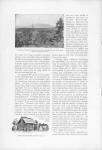
Rugged old Black Mountain looms up over its neighbors of the same
range like a great fortress.
|
| 14 |
lots015 |
they offer. Horseback
riding is in great favor, but because of the hills, bicycling is but
little indulged in. Out-of-door life, especially with tourists, is
the rule, and there are mountains near enough to be considered for a
day's excursion which will tax the endurance and skill of all save
the professional Alps climber. During the spring and early summer
these mountain sides are radiant in the blossoms of the laurel, the
rhododendron, and the azalea, and for miles along the edges of the
purling Swannanoa its banks are one solid mass of these exquisite
flowers. With every turn of the road a new and exquisite panorama is
spread before the enraptured gaze. Peak after peak comes into view,
rising to majestic height and clothed to the very summit with deep
green forest. It is a matchless region, to which all others except
those of the far West are incomparable.
About two miles from the heart of Asheville, and upon one of the
steps of the mountain range, is Mr. George Vanderbilt's magnificent
chateau, the chef d'ouvre of the late Richard M. Hunt's
architectural creations. It was begun in 1890 and was completed in
1895. The building is said to have cost up ward of $3,000,000, and
as much more has been expended upon its surroundings and the vast
estate of a hundred thousand acres. All of the landscape gardening
and the development of the park shows the master hand of Mr. Fred.
Law Olmstead, under whose direction the improvements have been made.
Miles beyond count of superb model roads have been constructed, and
hundreds of thousands of flowering plants and shrubs have been
artistically grouped. In every line of agriculture, forestry, and
floriculture there has been the highest development under expert
direction, in order not only to improve the place itself, but to... |
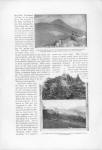
Grandfather Mountain, one of the highest peaks of
"The Land of the Sky, is plainly visible for many miles from all
points of the compass.
|
| 15 |
lots016 |
IN SOME
PLACES THE WALLS OF THE MOUNTAIN SIDES RISE ALMOST PRECIPITATELY TO
DIZZY HEIGHTS |
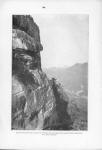 |
| 16 |
lots017 |
...furnish a working
model which would be an influential factor in raising the standard
of the entire region, and State.
The mansion is a
rather highly elaborated version of the architecture of Francis I.
and of the chateaux of the Loire. It is exceedingly rich in every
detail, and the general effect is heightened by the free employment
of decorative sculpture. Those who have stood spellbound upon the
esplanade of this magnificent chateau and looked out upon the wild
tumult of mountains which stretch away in every direction until lost
behind the curtain of the horizon, can well understand why Mr.
Vanderbilt selected this particular spot of all others in America
for the erection of a home which is as supreme
among the houses of
men as this spot is among the creations of Nature.
Among the latest and
the most attractive improvements in or about Asheville is Albemarle
Park, with its charming manor house of English quaintness as a
central figure. The Park proper embraces a tract of thirty-four
acres of glen and mountain-side, and fronts on Charlotte street. At
the entrance stands an artistic lodge built of rough stone, and a
perfectly constructed boulevard stretches away to the manor and its
nearby cottages. The former is neither an hotel nor a
boarding-house. It differs from both. It is unique in itself. The
purpose of its original design was to provide a perfectly
comfortable place to live, attractive in its surroundings, complete
but modest in its appointments, and carrying that air of refinement
essential to the comfort of cultivated people.
Although as nearly
like a home as public houses can well be made, it is free from the
highly organized service of the hotel with its consequent bustle and
noise, and likewise from the unmethodical service, the restricted
comfort, and isolation of the boarding-house.
It is located on the
line of the electric railroad that reaches the centre of town in a
ride of seven minutes, and the Southern Railway station in
twenty-three, yet in touch with the woodland that covers the
mountain slopes of Albemarle Park.
The rooms are all
front rooms; one side opens upon a fine view of the range of Western
mountains across the valley, and the other upon Albemarle Park with
its picturesque cottages, wooded slopes, and serpentine macadam
roads.
The idea of the hotel
is that it shall be entirely different from an American hotel,
something on the plan of an English inn, making it a comfortable
home for people to reside in.
The drainage of the
whole tract has been completed under the most scientific principles,
under drawings and specifications by the late George E. Waring's
firm, and the subsidiary roads and designs for planting, which are
very elaborate, have been designed by Samuel Parsons, Jr. 7
ex-Superintendent of Central Park, New York ; the buildings have
been designed by a well-known architect of New York.
Sewers and surface
drainage have been put in, involving about a mile of sewer line to
make connection with the |
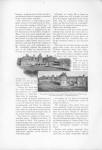
The English-like Manor in Albemarle Park,
Asheville, is neither a hotel nor a boarding-house. It differs from
both.
|
| 17 |
lots018 |
city sewers. The city
water main has been extended through the Park, and electric wires
for lighting.
Taken as a whole,
Asheville more nearly than any other city in America meets all the
requirements of a natural sanitarium and resort. In climate it is
perfection, in scenery unequalled by any place east of Colorado. It
is easily accessible by through trains upon the Southern Railway
from the West or East, North or South. It has hotels which are
admirably appointed and well-kept, and a large number of homelike
boarding-houses. Spring or fall, winter or summer Asheville is an
ideal spot on which to seek either recreation or health.
From Asheville the
tourist or health-seeker may turn in any one of several directions
and find charming localities in the midst of the mountains, where
the scenery is sublime and awe-inspiring, and where there are
excellent accommodations awaiting him in the form of comfortable
hotels. The grandest and wildest scenery is, perhaps, to be found on
that portion of the Southern Railway running from Asheville to
Murphy. The first stage of the journey ends at Waynesville, so
called in honor of Mad Anthony Wayne. It is the highest railroad
town east of the Mississippi River, the seat of Haywood County, and
one of the most beautifully situated towns in the mountain section
of North Carolina. Its location is in the centre of the Richland
Valley, at the very foot of the noble Balsam range of mountains,
several peaks of which attain an elevation of over six thousand
feet. These mountains are clothed from base to summit with a dense
forest, the deep green fir balsam, whose odors exert an extremely
healing influence upon weak throats and lungs, predominating. As a
resort for invalids, the locality offers strong inducements. This
section has an elevation of 2,800 feet above sea level, and such is
the wonderful purity of the air that persons suffering with nervous
prostration, or from the effects of overwork, obtain immediate
relief. Its altitude insures a cool summer, and it is far enough
south for a comfortable winter. The nights in summer are always cool
and refreshing, insuring- sleep. Waynesville's population is about a
thousand. The streets are broad and well shaded. There is a fine
court-house, a public library, numerous attractive residences, and
substantial business men in all branches of trade. The famous Hay
wood White Sulphur Springs, with its large hotel, is near
Waynesville on the opposite (north) side of Eichland Creek, which,
even within the town limits, has its picturesqueness preserved, if
not increased, by the old mills and the fine old oaks and beech
trees which grow along its course, and by the distant background of
forest-covered mountains.
Throughout the entire
distance between Waynesville and Murphy the country is sparsely
settled, and so little affected by the inroads of modern
civilization that over much of the area one may see the clear
streams, the dense forests, and the rugged mountains in their native
wildness and beauty. Cherokee Indians have, until recent years,
traversed the forests and wandered along the streams which their
fathers named: the Tuckaseegee, Savannah, Tennessee, Elijay,
Cartooga-jay, Tuskeegee, Oconaluftee, Stekoah, Tusquittah,
Nantahala, and others. It is a wilderness as sublimely beautiful as
it is solitary and grand, an Elysium for the health-seeker, a
paradise for the sportsman.
During long ages of
the past these streams have been carving, deeper and deeper, their
channels between the mountains. So slowly has the work progressed,
and so vigorously has the vegetation grown, that everywhere from the
mountain tops to the banks of the streams the surface is covered
with trees, shrubs, and flowers.
The gorge of the
Nantahala River, through which the railway passes for more than a
dozen miles, is by many believed to be the most picturesque and
beautiful in western North Carolina. One of the full-page
illustrations shows the upper end of this gorge, looking northeast
down the river. Oil the right Clift Ridge rises almost perpendicular
to nearly 2,000 feet above the river; while on the left the spurs of
the Great Smoky Mountains |
 |
| 18 |
lots019 |
rise nearly as high
and are nearly as steep. Between their bases the gorge is so narrow
that in many places there is hardly space enough for both the
railroad and the river. Talc and marble abound
in these rocky,
forest-covered slopes, and the lumbering and timber interests at
Dillsboro, Bryson City, and other points are very extensive.
On the line of the
Southern Railway between Asheville and Spartanburg, S.C., there is a
beautiful a 11 d picturesque region which has long been extremely
popular with tourists, and in which there are numerous resorts, well
patronized both in summer and winter. The nearest of these resorts
to Asheville is S k y 1 a n d, an attractive little place nestling
down close under the protection of the nearby mountains. Beyond is
Henderson, twenty miles from Asheville, and located in full view of
the
mountain peaks of
Tryon, Little Hog Back, Glassy, Pinnacle, Caesars Head, Hebron, Hog-
Back, Pisgah, Busby, Craggy, Black, Hooper's, Bear Wallow, Sugar
Loaf, Chimney Rock, the Shaking- Bald, and Point Lookout, which,
rising above the plateau, form a complete panorama and amphitheatre,
making the view from the town grand and majestic beyond comparison.
Southwest from
Henderson and reached by a short road to Brevard, where broad spurs
point off from the main chain of the Blue Ridge toward the lowlands
of South Carolina and Georgia, is the Sapphire country, a region
full of delightful surprises to the tourist, sportsman, and
healthseeker. No other section contains more clear, cold, an d
wonderfully picturesque streams, so many grand waterfalls, such
wide-sweeping mountain views, such beautiful lakes, and verdure-clad
valleys.
The most attractive
features to be found are the Fairfield and Sapphire lakes |

Lakes
Fairfield and Sapphire in the heart of the North Carolina
mountains are duplicates of the most beautiful
gems
of the Adirondack.
[Photos
by R.H. Scadin] |
| 19 |
lots020 |
THE CHATEAU OF MR. GEORGE
VANDERBILT, ' BILTMORE '' (ASHEVILLE), N. C.[Biltmore
Estate] |
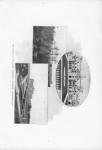 |
| 20 |
lots021 |
Nowhere else in the
South, at this altitude, are there such bodies of water of wonderful
beauty and greatly varied character. There are towering cliffs,
rising1 abruptly for a thousand feet from their shores, and cascades
of rare clearness falling directly into the lakes from the lofty
tableland surrounding. Indeed it is the general verdict of widely
traveled people that, in respect to the remarkable combination and
varied and attractive character of lake and mountain scenery this
section is unrivalled by any in the world. Certainly no other part
of America has anything to surpass it.
Until recently there was no provision made for the accommodation
of visitors to this delightful section. Now, however, entertainment
is offered at the Sapphire Inn (on Lake Sapphire), Mountain Lodge
(on summit of Mt. Toxaway), and the magnificent new hotel, Fairfield
Inn, on Lake Fairfield. Sapphire Inn, with cottages, will
accommodate about fifty guests, and is kept open all the year. The
grounds are spacious and well kept. There is an excellent livery in
connection with the house, and a number of pleasure boats have been
placed on Sapphire Lake for the use of the guests. The fishing on
this lake is unsurpassed.
Three and one-half miles distant from Sapphire, on the summit of
Mt. Toxaway, is the Lodge. This house is easily accessible from
either of the lake houses by a nicely constructed and well-graded
road, winding back and forth along the sides of the mountain for a
distance of about three and one-half miles. The accommodations
provided here for guests will be found of the most satisfactory
character, There are good stables in connection with the Lodge, thus
making the place one of a specially attractive nature for mountain
parties. The view from this Lodge, which is on the extreme summit of
the mountain, is the most extensive (it being an isolated peak) of
any mountain point of vantage in North Carolina, probably in the
entire Alleghany chain. The magnificent character of this view
cannot well be described. Its grandeur and sublimity can only be
felt and fully appreciated by looking out upon it.
Fairfield Inn is beautifully situated on the shores of Lake
Fairfield. It is a modern house in every respect, with excellent
water-supply, good baths, electric lights, etc. It has wide spacious
porches and commodious public rooms, while well-kept grounds and
parks, good boating and bathing, serpentine drives and shady walks
about and around the lake... |
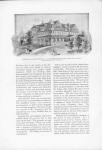
Fairfield Inn on Lake Fairfield, N.C. is a modern
summer hotel, in which every comfort and convenience will be found.
|
| 21 |
lots022 |
IN MANY PLACES THE MOUNTAIN SIDES
PRESENT A WILD AND FORBIDDING ASPECT. |
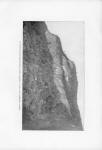 |
| 22 |
lots023 |
...make it an ideal
place for health or pleasure-seekers.
The estate connected
with, the hotel contains about twenty-six thousand acres. It is well
stocked with various kinds of game and is under perfect patrol.
There are seventy-five miles of river and brook fishing. Brook trout
here have been taken weighing two pounds. The only restrictions made
as to hunting and fishing are such as usually obtain about any
well-ordered game preserve. The large and carefully cultivated farms
and the numerous apple and peach orchards of the company supply the
houses with a great variety of fresh vegetables and fruits. On the
extensive pasture lands of the company graze numerous flocks of
sheep and herds of cattle, the latter being selected with a view to
their excellence for the dairy, which supplies fresh milk and cream
in abundance at all times.
Many miles of roads
have been graded around the margins of the lakes and over the
property with a due regard for views which cannot be well surpassed
for beauty and grandeur. Within a radius of ten miles of Sapphire
there are fifty waterfalls, all of them being easily accessible. The
height of these falls ranges from fifty to three hundred and seventy
feet.
Whiteside Mountain,
which has the highest perpendicular face east of the Mississippi, a
wall two miles in length and eighteen hundred feet sheer drop, is
one of the grandest mountains in America, and can be conveniently
reached from either house. This, with the cliffs of Bald Rock,
Chimney Top, Laurel Knob, and Green Mountain, gives to The Toxaway
country a picturesqueness peculiarly its own. There are a hundred
other attractions, combined with those enumerated, which makes this
one of the most notable mountain resorts in the world.
To the forester,
botanist, and geologist, this country about Sapphire is a veritable
storehouse of wonders. Here is truly the forest primeval. In the
spring and early summer hundreds of bright colored flowers light up
the old woods; here rhododendrons grow to a height of thirty feet;
the air is fragrant with perfume, and amid these old hills are
treasures of wealth yet to be uncovered. The globe offers no greater
natural sanitarium than here, where every breath, charged with
ozone, develops pounds of energy and where all the conditions for
perfect health exist in the highest degree. On the very hottest day
in summer the thermometer has never registered above 87 degrees,
while a record of the temperature kept at Sapphire for the past four
years shows it to be an average of 69 degrees for the entire summer.
Visitors from the
North and East reach Sapphire via Asheville and Hendersonville, N.
C., to Brevard, N. C. From the South and Southwest via Spartanburg,
S. C., and Hendersonville, to Brevard.
Three miles beyond
Henderson is Flat Rock, one of the most charming little resorts in
western North Carolina, and a spot where many prominent people from
Southern cities spend the summer months. It is in appearance a
little corner of old England tucked down in this North Carolina
paradise.
While only a quiet
little hamlet of mountaineers, Flat Rock was discovered many years
ago and taken possession of by a company of French and English
gentlemen who owned lands in South Carolina and Georgia. Among the
very first were the Count de Choiseul, the Barings, the British
consul, Molyneaux, and a half dozen or so of planters and their
families from the coast, who, finding this climate |
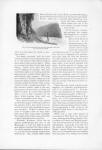
On the French Broad River near the Tennessee line
there are many rocky bluffs.
|
| 23 |
lots024 |
so entirely different
from their own, the place so unique of all others in the mountains,
set up their summer lodges here. At the present time these places,
about fifty in number, cover an area of five or six miles, and are
picturesquely wooded with the fragrant pine, the oak, the hickory,
dogwood, sassafras, the crimson maple, the hemlock, and the holly,
thickly interspersed with the beautiful mountain laurel and azaleas
of colors the most gorgeous and the most delicate, while flowers and
ferns fringe with beauty ''the banks and braes and streams around."
Streams flow into artificial lakes shut in by rugged hills, and
beautiful with, blue inverted skies.
Paths winding through the sweet shades lead out upon different
points of interest, among them the quaint and picturesque church
built eighty years ago by the Barings, of London banking fame, and
called "St. John in the Wilderness." Its nearby vine-covered rectory
is so classical that one involuntarily expects to see the Vicar of
Wakefield step out from its portals. Flat Rock is provided with
ample accommodations for the entertainment of guests, and no more
restful or healthy spot exists on the American continent. All of the
neighboring old estates are thrown together in such a way that
visitors, who are always welcome to do so, may enjoy many miles of
beautiful drives from which the loveliest of mountain and nearby
views may be enjoyed.
Saluda, nine miles beyond Flat Rock, is 2,250 feet above sea
level. In approaching it from the south there is for three miles an
ascent of 237 feet to the mile, two locomotives being necessary on
each train. The little town, handsomely situated on this elevated
plateau, is nestled amid forest-covered hills ranging from 100 to
400 feet above the depot. On these hills families, principally from
Columbia, Charleston, and the coast, have built their airy, shady
homes, and spend their summers enjoying, in the cool breezes of the
mountains, the repose of country life without its loneliness.
Saluda has two good hotels and several boarding-houses, so that
the stranger within its gates is certain to find accommodations of a
satisfactory type.
The little town of Tryon is forty-three miles from Asheville and
twenty-seven from Spartanburg, and is 1,500 feet above sea level.
The scenery hereabouts is beautiful beyond description. The
mountains are covered to their very summits with verdure, and
whether in the budding of spring, the full foliage of summer, or the
gorgeous coloring of autumn, the ever-changing picture is always one
of beauty, charming to the eye. The waterfalls and cascades of the
Pacolet River and its tributaries are far-famed. The Horseshoe
Falls, on Spring Mountain, tumble down the mountain side a distance
of 350 feet. A good road leads to the top of Rocky Spur, a peak
4,000 feet high, a trip that can be made between breakfast and
dinner; and the sightseer will find a comfortable hotel, the Skyuka,
near the top of Tryon. Mountain, passing en route under the
celebrated Horseshoe Falls. The roads about Tryon are being
improved, and a day's ride through this picturesque country will not
soon be forgotten.
No chapter upon the scenic beauties and attractions of the "Land
of the Sky" would be complete without reference to that magnificent
portion known as the Grandfather's Mountain and Blowing Rock region,
which lies northeast of Asheville, between Lenoir and Cranberry, and
chiefly in Watauga County, North Carolina. To reach it, travelers
leave the Southern Railway at Hickory, which is between Salisbury
and Asheville, and take the Carolina & Northwestern Railroad to
Lenoir, twenty miles distant.
Lenoir has a population of about 2,000, and is a very attractive
mountain town. It enjoys a large local trade, which comes from the
rich agricultural section that surrounds it. It also has extensive
lumber interests, being one of the largest hardwood markets in the
Southern States. The town is built upon an elevated tableland
between two ranges of mountains, and the horizon line on all points
of the compass is broken by the graceful summits of towering ranges.
From Lenoir to Cranberry, over near the Tennessee line, stretches
one of the most magnificent mountain boulevards on the American
continent. It can be |
 |
| 24 |
lots025 |
compared only to the
Furca and other famous passes of Switzerland. It is fifty-six miles
between the two places, and for nearly half of this distance a full
trot may be held in one long sweep around dizzy heights and along
the edge of deep-shadowed gorges. The finely graded road hugs the
mountain side closely, and with every turn there opens before the
vision an entrancing panorama of graceful forest-clad summits above
and lovely valleys below. If the journey be made in May or June, the
banks of the streams and acres of the lower mountain sides will be
radiant in the blossoms of the rhododendrons and azaleas. Look where
you will, from the crystal streams clashing down the mountain-side
to the lowering summit of Grandfather's Mountain, which is always
coming into view, and each time showing a different face, the
panorama is one of surpassing loveliness.
Off to the south and
west rise Table Rock, Hawk's Bill, King's Mountain, Mitchell's Peak
(the highest east of the Rockies), and, towering above them all,
because of its proximity, the Grandfather, its top the profile of an
old man's face. The road winds among the hills for six or seven
miles, and then strikes the Yadkin River, and follows it to the
cool, bubbling spring, which is its source. The scenery grows more
wild and rugged as we climb; so dense is the undergrowth which
springs from the black mould that we wonder how the squirrels which
are frisking about have the temerity to venture into such a tangle.
The horses struggle up the ascent turning a sharp angle in the road,
the whole world, as it were, lies below us. We look sheer down into
the tree tops which skirt the John's River, and then out into the
sweeping lines of the Blue Ridge as they rise, range upon range, and
seem to melt into the blue of the sky. If the start from Lenoir has
been made in the afternoon, the air grows chilly before the summit
is reached, and search is made among the luggage for shawls and
rugs. As day declines, the sun seems to pause a moment on a distant
peak, flooding all the surrounding mountains with violet light, and
then sinks to rest. The darkness falls quickly. You are tired now
and close your eyes a moment; but someone breaks in upon your
reverie with an exclamation |
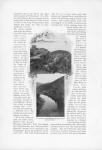
The summit of Grandfather Mountain and lake at its
base.
|
| 25 |
lots026 |
of wonder. You look up to
find the world flooded with, moonlight. It rests like a halo over
the mountains, and tips every fern and balsam bough with silver. You
climb on, a mile perhaps, amid this glory, when the tired horses,
admonished by voice and whip, break into a brisk run, and the hotel,
all aglow with the ruddy light of open wood fires, stands hospitably
before you, the first stage of the delightful and fascinating
journey being ended.
There are three hotels at Blowing rock, the Wautauga, the Blowing
Rock, and the Green Park. The view from the highest pinnacle of
Blowing Rock, which has an elevation of 4,340 feet, is sublimely
beautiful, and all the earth seems at one's feet. Range after range
of mountains comes tumbling in from the horizon line like the waves
of the sea, and as far as the eye can reach in every direction the
view is one of sublime grandeur and beauty.
|
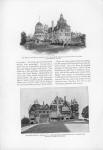
The Battery Park Hotel, Asheville, is one of the
best known resort hotels in America and is open all all the year. |
| 26 |
lots027 |
Here summer reigns
with moderate sway - during the season 85 is the highest temperature
recorded; for two successive Augusts the daily maximum ranged from
67° to 84°. The days are pleasant; the
nights more pleasant, if possible; a seat by an open fire and a
sleep under blankets make the dark hours delightful; nerves regain
tone, muscles grow strong, blood reddens, dyspepsia and headaches
flee away in the life-giving atmosphere above the clouds of the
valleys.
Points of vantage for views abound. No
two give the scores of mountain sides or tops from the same
direction or at the same angle; the sights are also kaleidoscopic in
variety.
at one place and hour there spreads
below you a white and silent sea of mist; in a moment the vast
surface begins to heave, to toss, to break; green peaks emerge from
snowy billows; hillsides next appear; and them the waves float
upward to the clouds, disclosing in all its bravery of field and
forest, winding streams and rocky cliffs, the great valley which
drains the waters from the southern slope of the Appalachian range.
From another point, and as the evening sun tips the crest with
flame, you see, as if they grew loftier while you look, the giant
tops of Roan and Grandfather, Bald, Yellow, and Black, scores with
no name at all, clean cut against a clear blue sky, so clam and
still, so mighty and reposeful, lifting the soul as they seem to
lift themselves.
Where the great spur already mentioned
joins the Blue Ridge, an overhanging shelf of rock projects from the
top so far over the "Globe" or valley of John's River as to catch
and for a time confine the currents of air scent up from the depths
as the northerly wind, finding no outlet, strike against the face of
the cliff. The air presently finds egress over the top, and the
force with which it boils up gives the name of Blowing Rock to the
beetling crag. When the winds are right, any light article,
handkerchief, scarf, hat, or bush thrown from the apex, instead of
reaching the bottom, thousands of feels below, is borne upward and
back again to the spot whence it was dismissed.
|
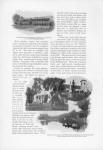
Church of St. John in the Wilderness and
Residence, Flat Rock , N.C. is picturesquely and historically
interesting. |
| 27 |
lots028 |
The name of the cliff
has become that of the village nearby where the road to Boone
intersects the old turnpike.
Blowing Rock is
preeminently cosmopolitan. There the summer girl may dress and dance
and ride to the very fullness of her heart's desire. Or she may let
her finery lay hidden in the depths of her trunk and go tramping
about in thick shoes and short skirts from sunrise until dark. It is
beautiful to watch the invalid's color come stealing back and the
poor little sickly children grow round-limbed and brown in the
bracing atmosphere. Verily, this is nature's great sanitarium, where
that good old mother takes her children into her lap and soothes
their jangled nerves: where the doctors are never in evidence and
the medicines always delightful.
The twenty-mile drive
from Blowing Rock to Linnville is over a road which for surveyor's
skill has no superior in America. For miles it traverses the forest
primeval, and from one point furnishes a view of matchless grandeur,
and from another a glimpse of some sweet, quiet valley with
perchance the modest home of some mountaineer and its little
clearing far away below. Everywhere the wild flowers grow in
profusion, and countless mountain streams murmur greetings as you
pass. Nine and a half miles beyond Blowing Rock the traveler comes
to the eastern boundary of the great park of 16, 000 acres owned by
the Linnville Improvement Company and the first view, from a point
1,500 feet above it, is had of the beautiful valley of the Linnville
River. Far away to the west and nestling in the heart of the valley
is the charming Eseeola Inn, with its surrounding picturesque
cottages. You may imagine it a little bit of Switzerland dropped
down in our own "Land of the Sky." The inn is of pleasing
architecture and has all the conveniences found in the best resort
hotels, including an excellent orchestra. From the Eseeola Inn the
main road continues to Cranberry, |
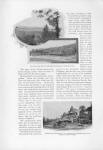
Eseeola Inn, at Linnville, N. C. is a beautifully
located house In the centre of a glorious region. |
| 28 |
lots029 |
and from here the
railroad may be taken to grandly beautiful Roan Mountain, Tennessee,
or on to Knoxville.
Near Cranberry, in
Mitchell County, and at an altitude of 3,750 is the Pineola Inn, a
charming colonial hotel, newly built and modernly furnished. It is
within driving distance of Linnville, Blowing Rock, Cranberry (its
P.O. address), and within a short, distance of Grandfather Mountain
(altitude 5,085 feet), and the beautiful "Falls" of the Linnville,
while the grounds of the inn extend to the water's edge of the wild
Linnville River.
Another section which
attracts many visitors because of its grand scenery is that about
Hickory Nut Gap and Chimney Rock. It is almost due east from
Asheville, and may be reached from that city by mountain conveyance.
The trip will amply repay the tourist, for the rugged, dizzy heights
and the deep, somber gorges are fascinatingly grand and sublime.
Tin-re is a hotel at Chimney 'Hock which furnishes comfortable
accommodations.
Hot Springs, on the
French Broad River, is the best-known resort in North Carolina after
Asheville. It is thirty-eight miles west of the latter place and but
a short distance from the Tennessee State line. It antedates
Asheville by many years, for as long ago as 1771 there was a
settlement here, and in 1790 the first public house was erected, as
even in those early days the wonderful curative properties of its
waters had become known, and the settlers for hundreds of miles
around were wont to bring their sick here for the benefits to he
derived from the baths. Today, Hot Springs of North Carolina is one
of the best-known health resorts in America, and its handsome hotel,
the Mountain Park, is frequently taxed to its utmost capacity to
accommodate the great number of its guests.
The railway, between
Asheville to the Hot Spring's, follows closely for the entire
distance the tortuous windings of the historic and beautiful French
Broad River.
Of such a stream the
poets might sing, for it is matchless in its setting of mountains
and in the beauty of its graceful curves.
|
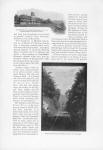
Where the railroad penetrates tunnels of rich
foliage.
|
| 29 |
lots030 |
Nearly the springs,
the mountains, as if determined to head it off in its mad race to
the lowlands, crowd in the closer and build high and rugged harriers
on either side, between which the river, lashed into a of fury of
foam, tosses and frets as if impetuous at the encroachment. Closer
and closer crowd in these mighty "battlements of nature" until it
seems as if the victory must ho theirs, when suddenly they spring
apart, as if abandoning the struggle, and sink away on either side
far into the distance, while the river, tired from the mighty
strife, glides out into tranquil pools and lazily meanders through
the broad and pastoral valley of the Hot Springs. About a mile
beyond the gorge is located the Mountain Park Hotel, crowning the
centre of a large and handsome private park. It stands close to the
river, along the bank of which are located the modern bathing houses
where the hot baths may he taken in handsome marble tubs under the
best medical advice. The hotel has accommodations for three hundred
guests, and is a well-managed, delightful place in which to sojourn,
whether one is ill or well. The waters are especially efficacious in
rheumatic and polity ailments, and have wrought many really
wonderful cures.
In the foregoing
pages have been given a few glimpses into the "Land of the Sky,"
which is rapidly becoming famous for its unequalled scenery and
perfect climate, but no type nor picture can convey an adequate
conception of the attractiveness of this region.
|
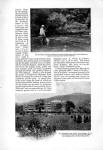 |


